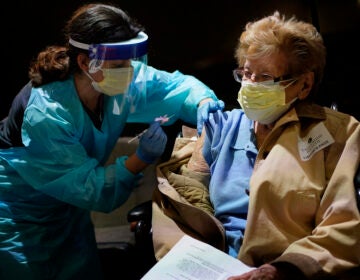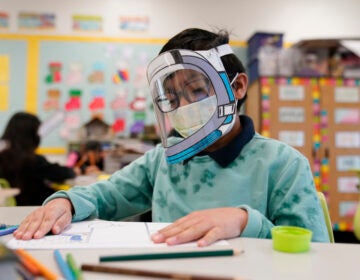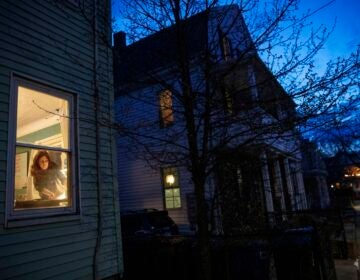Feared ‘twindemic’ never came, as flu season has been almost non-existent in Del.
Two top Delaware doctors credit the widespread use of masks, physical distancing measures, and the fact that fewer kids are in school.
Listen 2:06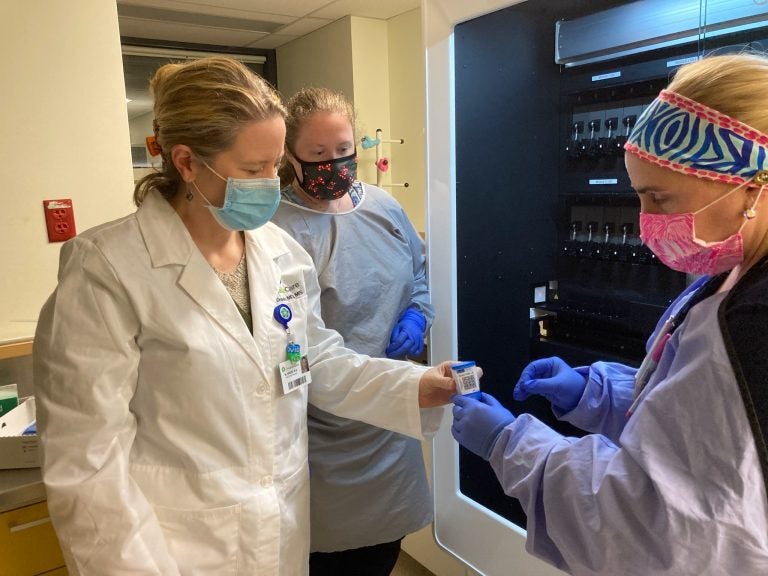
From left, Dr. Marci Drees reviews respiratory samples with scientists Alexa Pierce-Matlack and Stephanie Levin at Christiana Hospital's microbiology laboratory. (Courtesy of Christiana Care)
Ask us about COVID-19: What questions do you have about the coronavirus and vaccines?
Dr. Marci Drees was nervous last fall.
With COVID-19 escalating after a summer lull and the flu season looming, the chief infection prevention officer for ChristianaCare health system in Delaware joined health experts across the nation in fearing a devastating double whammy from the infectious viral diseases.
As predicted, the coronavirus raged through the late fall and winter, hitting Delaware, the region and nation hard. Since the unofficial Oct. 1 start of the flu season, the state has had 71,000 COVID-19 cases. That’s three-fourths of the 95,000 infections that have occured in Delaware since the first positive test result in early March 2020.
Influenza has been almost nonexistent, however.
By this time last year, Delaware had nearly 7,000 documented flu cases and 11 deaths. But this year the count is just 21, with one fatality. The rest of the Philadelphia region and nation also has experienced an unusually low number of flu cases.
That’s been welcome news to Drees.
“We were all really worried,’’ Drees said. “Could we have what they call the ‘twindemic,’ a flu epidemic on top of a COVID surge? And what would that do to hospital capacity and everything else? And luckily, the normal seasonal flu epidemic just really never happened.”
Measures aimed at limiting the spread of the more-infectious coronavirus are a key reason, she said.
“It’s the focus on masking, kind of shutting almost everything down, physical distancing, focusing on hand hygiene and environmental cleaning,’’ Drees said. “The fact that people aren’t traveling. The fact that kids until more recently weren’t in school, weren’t in day care. Just people weren’t interacting the same way that they normally do, which is how these viruses spread.”
Drees also speculates viral interference played a role. That’s when a cell infected by one virus becomes resistant to another infection.
“If you get sick, if you get a cold first, you’ve ramped up your immune system,’’ Drees said. “So you have had your specific antibodies that are trying to target that specific cold virus, but you’ve ramped up everything else in your immune system. If you’re then exposed to flu, it can actually be very difficult to get that secondary infection.”
She shrugged off the notion that people with the flu are wrongly diagnosed with COVID-19. She said while many COVID-19 symptoms are similar to those of influenza — fever, chills, aches, difficulty breathing — the diseases only rarely occur at the same time in the same person, and that tests for the two are different.
Dr. Rick Hong, medical director for the Delaware Division of Public Health, was similarly concerned that “both flu and COVID would be running rampant” at the same time.
The fact that they did not led him to believe that many of the measures for preventing COVID-19, and consequently the flu, could become the new normal for some people going forward.
“I do anticipate that people will still wear masks, especially those at high risk. I think people will be more cognizant of hand hygiene,” Hong said. “So I’m hoping that we have learned some lessons during this entire pandemic and hopefully that we will continue some of these safe measures that we are following now in the future.”
Drees agreed.
“Now, we don’t want to do all these things every flu season,’’ she said.”We don’t want to have to shut down the economy and tell people they can’t travel, that sort of thing.
“But what can we continue to do while still living a relatively normal life? I think masking is one thing, especially if you’re around vulnerable people, especially if you have any symptoms at all.”
Drees also suggested people might become less likely “to tough it out” and go to work when they are sick.
“I think we’ve learned a lot about how to work remotely. If they are feeling a little bit under the weather, but not necessarily so bad that they can’t work, maybe they work from home that day, if that’s an option for them to avoid exposing other people.”
Both doctors also stress that neither COVID-19 or the flu are going away, and urge everyone to get vaccinated for both.

Get daily updates from WHYY News!
WHYY is your source for fact-based, in-depth journalism and information. As a nonprofit organization, we rely on financial support from readers like you. Please give today.



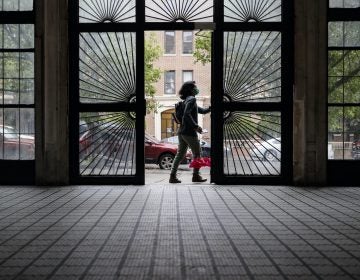

![CoronavirusPandemic_1024x512[1]](https://whyy.org/wp-content/uploads/2020/03/CoronavirusPandemic_1024x5121-300x150.jpg)
